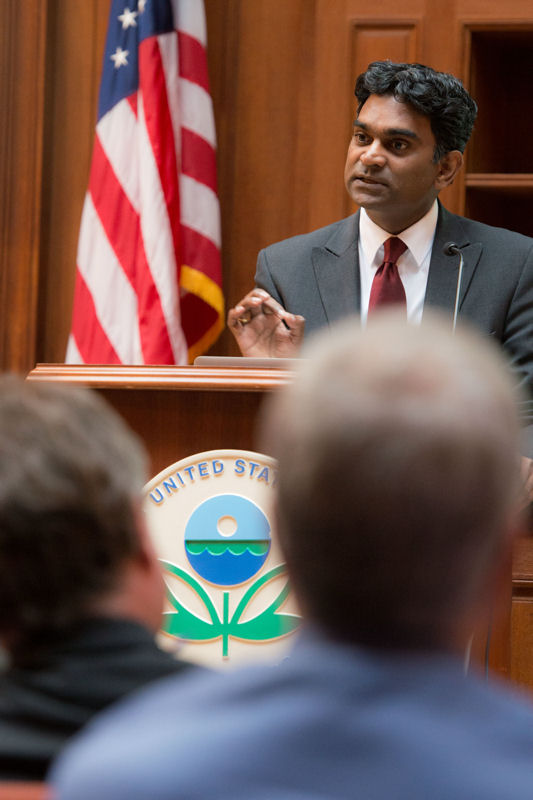
Kalanithy Vairavamoorthy is dean of the Patel College of Global Sustainability at the University of South Florida (Tampa). Photo courtesy of Eric Vance ©U.S. EPA.
On May 14, Kalanithy Vairavamoorthy presented a lecture about the need to revolutionize water infrastructure. Vairavamoorthy, dean of the Patel College of Global Sustainability at the University of South Florida (Tampa), spoke at the U.S. Environmental Protection Agency (EPA) headquarters building in Washington, D.C., to a crowd of nearly 150.
His lecture, “Innovation in Urban Water Infrastructure: An Imperative To Achieve Sustainability,” discussed doing more with less by integrating infrastructure systems, harvesting resources, transitioning from current to future infrastructure models, incorporating flexibility into design, using “smart thinking” for technology and networks, and optimizing infrastructure at appropriate scales.
Revolutionized thinking

Vairavamoorthy presented a lecture at U.S. Environmental Protection Agency headquarters about the need to revolutionize water infrastructure. Photo courtesy of Eric Vance ©U.S. EPA.
Throughout the lecture, Vairavamoorthy used examples from across the globe to show how these different principles are being used to bring water resources management into the 21st century. He talked about moving away from such outdated principles as creating urban areas without input from water professionals. “We just plumb it later,” he said; we rely too heavily on large centralized systems, treating stormwater as a waste, and failing to break down institutional and regulatory hurdles that hinder innovation.
Vairavamoorthy provided what he coined “take-home messages” to help overcome these hurdles. Some the them include the following:
- Manage water supply, wastewater, and stormwater together (one urban water cycle), and think creatively about potential water sources without focusing on the obvious ones.
- The driver for water management should be beneficiation, maximizing value added; institutions and regulations should support, not hinder.
- Move away from tinkering and think about how you might have designed from scratch, then look at transitional pathways, and don’t be afraid to decommission infrastructure.
- Move away from a deterministic, path-dependent approach toward a more flexible and adaptive approach.
Throughout the lecture, Vairavamoorthy also reinforced the need to incorporate these ideas into education to make sure they are accepted and grow. He advocated delivering these messages to both engineering students and urban leaders.
Spurring innovation
The lecture was one of a series of ongoing events and meetings to help drive innovation in the water sector. The Water Environment Federation (WEF; Alexandria, Va.) and the Water Environment Research Foundation (WERF; Alexandria) organized the event in coordination with EPA. Nancy Stoner, EPA acting assistant administrator for Water; Glenn Reinhardt, WERF executive director; and Matthew Ries, WEF chief technical officer, provided opening remarks.
In March, the EPA Office of Water released its Blueprint for Integrating Technology Innovation into the National Water Program; it outlines EPA’s commitment to advance and promote use of innovative technology to advance the goal of clean and safe water and sustainable water utilities.
In 2012, WEF and WERF launched LIFT, the Leaders Innovation Forum for Technology, designed to help move innovation into practice in the water quality industry.
— Steve Spicer, Highlights










May 31, 2013
WEF Resources & Efforts